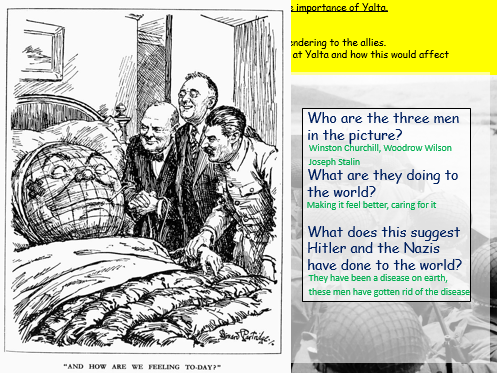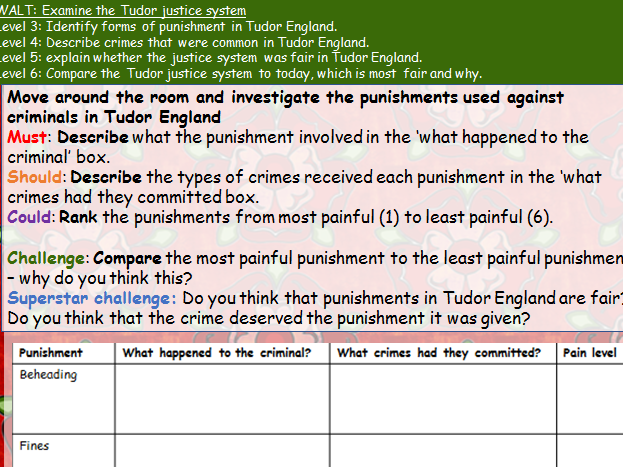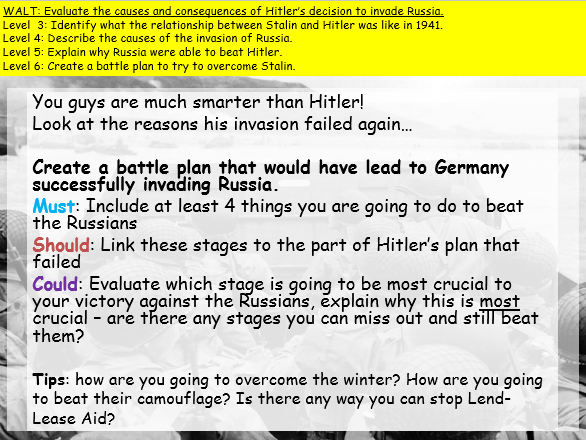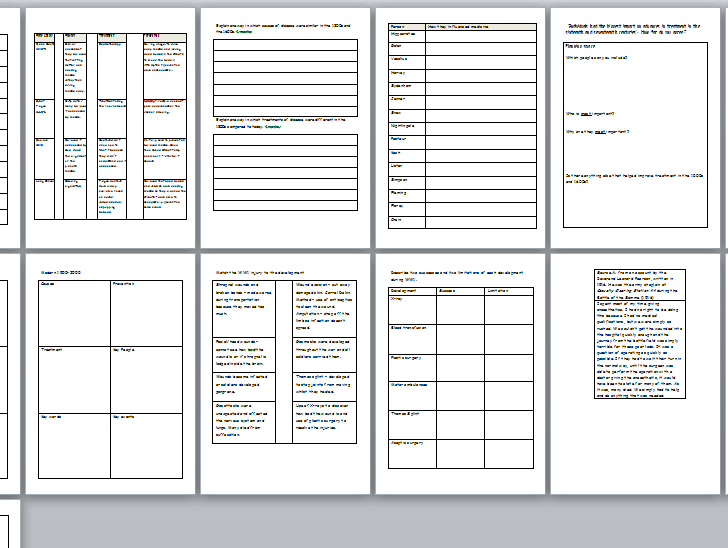
177Uploads
76k+Views
24k+Downloads
History

Weimar and Nazi Germany Timeline and Lesson (Edexcel 9-1)
Timeline with sections for pupils to create - worksheet to support.
Fully differentiated lesson to go alongside the timeline.
Starter: structure of Paper three
task one: overview video
Task two: timeline - defining key words, describing key events and extension task
Whiteboard AFL
Task Three source work - why vote for hitler? challenge: making links to key events on the timeline
Task designed as an introductory lesson to paper three to give pupils an overview of the topic so assumes no prior knowledge but could also be used as a revision task.

REVISION Rebellions and exam skills (Edexcel 9-1: Anglo Saxon and Norman England)
WALT: Revise the rebellions against William and evaluate how big of a threat they made towards his reign
Identify reasons people were upset with William’s leadership
Describe each rebellion.
Compare rebellions to explain how William responded to each threat.
evaluate how far you agree with a statement to come to a clear judgement
As with all of my revision lessons the worksheets cover all tasks so that pupils do not require their exercise books.
Task one: what did people have to be unhappy about?
Task two: Video task
Task three: line task (pictured as cover image) alongside information sheet to help pupils remind themselves of key content.
Task four: Exam question from past paper fully planned on slides to support pupils

REVISION Keeping Control (Edexcel 9-1: Anglo-Saxon and Norman England)
Session designed to revise the key theme of Norman Control after the Battle of Hastings. As with all of my revision lessons this is fully resourced and fully worksheet based so that exercise books/lined paper are not required.
WALT: Revise and explain how William kept control of Norman England.
WILF 1: Identify methods William used to keep control of England.
WILF 2: Describe five methods of control and Explain at least three in detail.
WILF 3: evaluate why William was able to keep control of England and apply knowledge to a 12 mark Q
Starter: identify 5 methods of control using the image (Exam 4 mark question as challenge)
Task one: create the feudal system and compare it to the saxon heirachy. (answers of similarities and differences on slide)
task two :video task (5 minutes)
task three: using the information sheet and own knowledge complete the mind map (see cover photo)
task four: 12 mark control exam question - can be set as homework.

Hereward the Wake and the rebellion at Ely (Anglo-Saxon and Norman England (Edexcel 9-1))
WALT: Explain what caused the Ely rebellion and why it failed.
1-2: recall and describe key features of previous rebellions studied.
3-4: Describe the role of Hereward the Wake in the Ely rebellion.
5-7: Explain the causes, main developments and consequences of the Ely rebellion.
8-9: Evaluate how and why the Ely rebellion failed.
Pupils will:
starter: complete choice of two exam questions, green pen and improve/attempt other exam question if full marks.
discussion: why the fens at Ely? link back to Gate Fulford.
Worksheet task: explain key features of the rebellion, link back to 1068 and 1069 rebellions
Explain task: why did the rebellion fail?
exam question: how far did you agree, exam plan and sentence starters.

End of Unit Consolidation (Edexcel 9-1: Anglo-Saxon and Norman England)
This lesson has been designed to be delivered at the end of the unit prior to assessment.
My class has a range of pupils targeted from grade 2-9, therefore my lessons are differentiated with this in mind at all times.
Pupils:
identify features of the feudal system through a starter activity
Describe the rebellions William faced (video and then hexagon revision activity)
Explain how William kept control of England (fully differentiated table, method of control and how it helped him keep control)
Analyse how far Lanfranc’s reforms increased William’s power (colour coding task, differentiated challenge for grade 4-6 and grade 7-9)

KS3 D-Day (WW2)
WALT: Explain why the Axis forces were defeated at D-Day.
Level 3: Identify hidden messages in US propaganda.
Level 4: Describe the key events of the D-Day invasion.
Level 5: Explain why Allied tactics lead to success.
Level 6: Compare the Allies and German tactics to explain why the Allies won.
Pupils analyse a source, follow a carousel to create the battle plan shown as the cover image, then read a source to compare British and German weaponry before creating a newspaper article about the invasion.

Chronology (What is history? (KS3))
Pupils explore the concept of chronology and how it supports historical learning, they are also introduced to the concept of a turning point and identify turning points in their own lives/across history. Includes a chronological order game of significant events from history.
WALT: define chronological order and apply this skill to historic events.
L3: Define what the term chronological means.
L4: create a timeline of events from history in chronological order.
L5: Explain what a turning point is.
L6: Apply skills to a timeline of my own life and evaluate the biggest turning point in my life so far.

KS3 Hitler's Downfall (WW2)
This lesson covers:
The Battle for Berlin
Hitler’s suicide
Yalta Conference
Pupils will:
WALT: Explain why the Nazi’s surrendered to the Allies and the importance of Yalta.
Level 3: Identify what position Germany was in by 1945.
Level 4: Describe the key events of the Battle for Berlin.
Level 5: Explain how the Battle for Berlin lead to Germany surrendering to the allies.
Level 6: Compare sources to analyse what the Big Three wanted at Yalta and how this would affect Germany.
Bundle

KS3 WW2 bundle
This unit of work has been created to embed and develop skills required at KS4 within KS3 written responses. Skills developed include source work (Interpretations and sources) as well as narrative account, consequences, and PEEL paragraphs.
Bundle includes lessons about:
D-Day
Defeat of France
Hitler’s defeat
Invasion of Poland
Operation Barbarossa
Pearl Harbour
The Blitz
WW2 Dictators

Tudor Crime and Punishment
This is a lesson aimed at KS3, it provides an overview of crime and punishment in Tudor times.
Pupils complete a carousel around the room in order to analyse the punishments that people received for certain crimes.
They then decide which punishments the criminals deserve (Anne Boleyn and Thomas Cromwell included) before comparing whether the Tudor justice system is fair with today’s justice system.

WW1 Medicine Revision Session (Edexcel 9-1)
Session covers the Western Front section of the Edexcel history 9-1 course.
Pupils cover:
features of a trench
features of the main battles
key medical problems
key medical advances
blood transfusions and x-rays (problems and solutions)
following up a source
Bundle

KS3 Elizabeth I
Full scheme of work consisting of 9 lessons exploring the reign of Elizabeth I.
All lessons fully differentiated and designed to embed skills required for the reformed GCSE’s.
Topics in order of teaching are:
Who was Elizabeth?
Who should marry Elizabeth?
Poverty and the poor laws
Education
Entertainment
Mary Queen of Scots - whats the problem?
Mary Queen of Scots - plots and execution
Armada - causes
Armada - events narrative account

Trench Medicine WW1
Pupils explore the problems soldiers, nurses and doctors faced as well as analysing the advances in medicine that helped soldiers overcome problems like trench fever, shell shock and shrapnel wounds.
Pupils analyse sources before completing a carousel and then making a leaflet advising a soldier about how best to protect themselves on the western front.

American West Key Words
two age document with key words for the unit on it - in line with Edexcel 9-1.
I went through the Pearson textbook and included all of the key words from front to back of the textbook.

Introduction to the Civil Rights Movement (KS3)
Part of a three lesson SOW about the CRM in America.
WALT: Evaluate methods used to fight for equality in 1960s America.
Level 3: Identify the meaning of the phrase Civil Rights
Level 4: Describe the Jim Crow Laws and examples of how they linked to life in the 1960s
Level 5: Explain methods in which Civil Rights leaders fought for equality.
Level 6: Analyse the methods you think would be most successful and explain why.
Starter: what does Civil Rights Movement mean? using Frayer model
task one: video task
Task two define and describe the Jim Crow Laws using images
Task three: describe and explain methods of protest
task four: analytical discussion and annotation of President Kennedy’s Civil Right’s Address.
Plenary: 3 - 2 -1 plenary task

KS3 Operation Barbarossa (WW2)
Pupils will:
Analyse a source to suggest what the relationship was like between Hitler and Stalin
describe two reasons Hitler chose to invade Russia - guided questions on the PPT for support
suggest what Britain should do - four options to engage pupils before they discover Churchill’s speech as a response
Explain why Stalin was able to beat Hitler - rank a worksheet and then explain one in detail.
create a battle plan as if they are Hitler, what could they have done to beat Stalin?
WALT: Evaluate the causes and consequences of Hitler’s decision to invade Russia.
Level 3: Identify what the relationship between Stalin and Hitler was like in 1941.
Level 4: Describe the causes of the invasion of Russia.
Level 5: Explain why Russia were able to beat Hitler.
Level 6: Create a battle plan to try to overcome Stalin.

REVISION Medicine Through Time and Western Front Overview
An hour and a half lesson aimed at intervention prior to the examination.
pupils are given an a5 booklet to follow along with the session, parts of which can be completed at home to build knowledge as last minute revision. This is the last session I use prior to Paper One.
Pupils cover:
key people, key discoveries, skills for all question types, source evaluation and judgement.

REVISION CLOCK: Weimar and Nazi Germany (Edexcel 9-1)
The concept of a revision clock is that pupils spend five minutes completing each section - thus meaning they revise a large amount of a single topic in an hour.
this resource includes two revision clocks, i plan to provide my pupils with it printed double sided, they will complete one side in class and one side for homework.
Another technique is to ask pupils to fill out what they know in one colour, and then use a second colour to revise using a revision guide or textbook, giving them a colour coded guide to what they need to focus their revision on.

REVISION CLOCK: Stresemann changes to Germany (Weimar and Nazi Germany Edexcel 9-1)
The concept of a revision clock is that pupils spend five minutes completing each section - thus meaning they revise a large amount of a single topic in an hour.
this resource includes two revision clocks, i plan to provide my pupils with it printed double sided, they will complete one side in class and one side for homework.
Another technique is to ask pupils to fill out what they know in one colour, and then use a second colour to revise using a revision guide or textbook, giving them a colour coded guide to what they need to focus their revision on.

AMERICAN WEST REVISION CLOCK (Edexcel 9-1: The American West)
The concept of a revision clock is that pupils spend five minutes completing each section - thus meaning they revise a large amount of a single topic in an hour.
this resource includes two revision clocks, i plan to provide my pupils with it printed double sided, they will complete one side in class and one side for homework.
Another technique is to ask pupils to fill out what they know in one colour, and then use a second colour to revise using a revision guide or textbook, giving them a colour coded guide to what they need to focus their revision on.




















